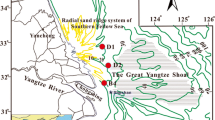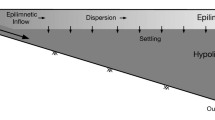Abstract
An ephemeral estuarine turbidity maximum (ETM) occurs at high water in the macrotidal Taf estuary (SW Wales, United Kingdom). A new mechanism of ETM formation, due to resuspension and advection of material by flood tidal currents, is observed that differs from classical mechanisms of gravitational circulation and tidal pumping. The flood tide advances across intertidal sand flats in the main body of the estuary, progressively entraining material from the rippled sands. Resuspension creates, a turbid front that has suspended sediment concentrations (SSC) of about 4,000 mg I−1 by the time it reaches its landward limit which is also the landward limit of salt penetration. This turbid body constitutes the ETM. Deposition occurs at high slack water but the ETM retains SSC values up to 800 mg I−1, 1–2 orders of magnitude greater than ambient SSC values in the river and estuarine waters on either side. The ETM retreats down the estuary during the ebb; some material is deposited thinly across emergent intertidal flats and some is flushed out of the estuary. A new ETM is generated by the next flood tide. Both location and SSC of the ETM scale on Q/R3 where Q is tidal range and R is river discharge. The greatest expression of the ETM occurs when a spring tide coincides with low river discharge. It does not form during high river discharge conditions and is poorly developed on neap tides. Particles in the ETM have effective densities (120–160 kg m−3) that are 3–4 times less than those in the main part of the estuary at high water. High chlorophyll concentrations in the ETM suggest that flocs probably originate from biological production in the estuary, including production on the intertidal sand flats.
Similar content being viewed by others
Literature Cited
Allen, G. P., J. C. Salomon, P. Bassoullet, Y. Du Penhoat, andC. de Granpre. 1980. Effects of tides on mixing and suspended sediment transport in macrotidal estuaries.Sedimentary Geology 26:69–89.
Consalvey, M., D. M. Paterson, andG. J. C. Underwood. 2004. The ups and downs of life in a benthic biofilm: Migration of benthic diatoms.Diatom Research 19:181–202.
Fennessy, M. J., K. R. Dyer, andD. A. Huntley. 1994. INSSEV: An instrument to measure the size and settling velocity of flocs in situ.Marine Geology 117:107–117.
Festa, J. D. andD. V. Hansen. 1978. Turbidity maxima in partially mixed estuaries: A two-dimensional numerical model.Estuarine and Coastal Marine Science 7:347–359.
Fox, J. M., P. S. Hill, T. G. Milligan, A. S. Ogston, andA. Boldrin. 2004. Floc fraction in the waters of the Po River prodelta.Continental Shelf Research 24:1699–1715.
Friedrichs, C. T. andD. G. Aubrey. 1988 Non-linear tidal distortion in shallow well-mixed estuaries: A synthesis.Estuarine, Coastal and Shelf Science 27:521–545.
Jago, C. F. 1980. Contemporary accumulation of marine sand in a macrotidal estuary, southwest Wales.Sedimentary Geology 26:21–49.
Mikkelsen, O. A. andM. Pejrup. 2000. In situ particle size spectra and density of particle aggregates in a dredging plume.Marine Geology 170:443–459.
Officer, C. B. 1981. Physical dynamics of estuarine suspended sediments.Marine Geology 40:1–14.
Postma, H. 1967. Sediment transport and sedimentation in the marine environment, p. 158–179.In G. H. Lauff (ed.), Estuaries. American Association for the Advancement of Science, Publication 83, Washington, D.C.
Schubel, J. R. 1968. Turbidity maximum of the northern Chesapeake Bay.Science 161:1013–1015.
Schubel, J. R. 1971. Tidal variation of the size distribution of suspended sediment at a station in the Chesapeake Bay turbidity maximum.Netherlands Journal of Sea Research 5:252–266.
Ten Brinke, W. B. M. 1994. In situ aggregate size and settling velocity in the Oosterschelde tidal basin (Netherlands).Netherlands Journal of Sea Research 32:23–35.
Uncles, R. J., R. C. A. Elliott, andS. A. Weston. 1985. Observed fluxes of water, salt and suspended sediment in a partly mixed estuary,Estuarine and Coastal Marine Science 20:147–167.
Uncles, R. J. andJ. A. Stephens. 1989. Distribution of suspended sediment at high water in a macrotidal estuary.Journal of Geophysical Research 94:14395–14405.
Uncles, R. J., J. A. Stephens, andR. E. Smith. 2002. The dependence of estuarine turbidity on tidal intrusion length, tidal range and residence time.Continental Shelf Research 22: 1835–1856.
Sources of Unpublished Materials
British Atmospheric Data Centere. unpublished data. Natural Environment Research Council, England, U.K.
National River Flow Archive. 1991–1995. unpublished data. Centre for Ecology and Hydrology, Wallingford, U.K.
Author information
Authors and Affiliations
Corresponding author
Rights and permissions
About this article
Cite this article
Jago, C.F., Ishak, A.K., Jones, S.E. et al. An ephemeral turbidity maximum generated by resuspension of organic-rich matter in a macrotidal estuary, S.W. Wales. Estuaries and Coasts: J ERF 29, 197–208 (2006). https://doi.org/10.1007/BF02781989
Received:
Revised:
Accepted:
Issue Date:
DOI: https://doi.org/10.1007/BF02781989




